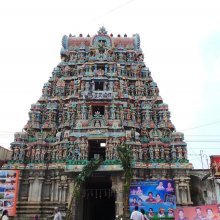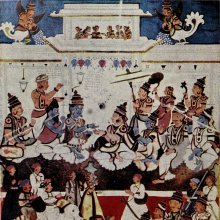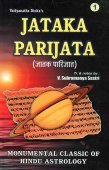Dikshita, Dīkṣita: 22 definitions
Introduction:
Dikshita means something in Hinduism, Sanskrit, the history of ancient India, Marathi, Hindi. If you want to know the exact meaning, history, etymology or English translation of this term then check out the descriptions on this page. Add your comment or reference to a book if you want to contribute to this summary article.
The Sanskrit term Dīkṣita can be transliterated into English as Diksita or Dikshita, using the IAST transliteration scheme (?).
Alternative spellings of this word include Dikshit.
Images (photo gallery)
In Hinduism
Dharmashastra (religious law)
Source: Google Books: Manusmṛti with the ManubhāṣyaDīkṣita (दीक्षित) is one who has been consecrated by means of the Dīkṣaṇīya-Iṣṭi. (See the Manubhāṣya verse 4.210)
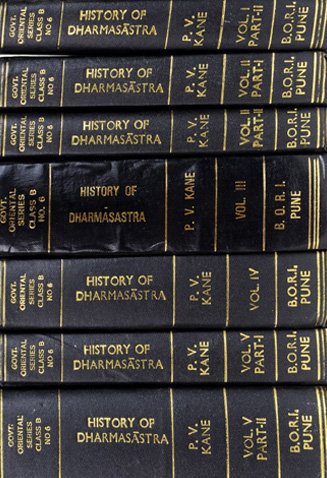
Dharmashastra (धर्मशास्त्र, dharmaśāstra) contains the instructions (shastra) regarding religious conduct of livelihood (dharma), ceremonies, jurisprudence (study of law) and more. It is categorized as smriti, an important and authoritative selection of books dealing with the Hindu lifestyle.
Natyashastra (theatrics and dramaturgy)
Source: Wisdom Library: Nāṭya-śāstraDīkṣita (दीक्षित, “prepared”) refers to ‘those who have consecrated themselves’ for some rites or for a Vedic sacrifice, whose mask should be represented as having a shaven head (śiromuṇḍa), according to Nāṭyaśāstra chapter 23. Providing masks is a component of nepathya (costumes and make-up) and is to be done in accordance with the science of āhāryābhinaya (extraneous representation).

Natyashastra (नाट्यशास्त्र, nāṭyaśāstra) refers to both the ancient Indian tradition (shastra) of performing arts, (natya—theatrics, drama, dance, music), as well as the name of a Sanskrit work dealing with these subjects. It also teaches the rules for composing Dramatic plays (nataka), construction and performance of Theater, and Poetic works (kavya).
Shaktism (Shakta philosophy)
Source: Google Books: ManthanabhairavatantramDīkṣita (दीक्षित) means “initiated”, according to the Manthānabhairavatantra, a vast sprawling work that belongs to a corpus of Tantric texts concerned with the worship of the goddess Kubjikā.—Accordingly, “There is (the energy which is) one measure (ekamātrā), two measures (dvimātrā) and three measures (trimātrā). The (energy which is the) half-measure is supreme and subtle. Above it is (the one reality which is both) supreme (transcendent) and inferior (immanent). It is the teacher’s place, the Great Place. The Self, which is endowed with the consciousness of its own consciousness, has come from that Place. The pure (beings) who are on their way to the Supreme should also be conjoined into that plane, initiated [i.e., dīkṣita] by Śrīnātha”.

Shakta (शाक्त, śākta) or Shaktism (śāktism) represents a tradition of Hinduism where the Goddess (Devi) is revered and worshipped. Shakta literature includes a range of scriptures, including various Agamas and Tantras, although its roots may be traced back to the Vedas.
Purana and Itihasa (epic history)
Source: archive.org: Shiva Purana - English TranslationDīkṣita (दीक्षित) refers to “initiation” (for the observance of ritualistic activities), according to the Śivapurāṇa 2.3.22 (“Description of Pārvatī’s penance”).—Accordingly, after Menā spoke to Pārvatī: “[...] Suppressing the delusion with fortitude after a long time Pārvatī, the daughter of Himavat, got herself initiated [i.e., dīkṣita] for the observance of ritualistic activities. She performed penance in the excellent holy centre Śṛṅgitīrtha which (later) acquired the title ‘Gaurī-Śikhara’ due to her performance of penance thereon. O sage, many beautiful holy plants were laid there by Pārvatī for testing the fruitfulness of her penance. [...]”.

The Purana (पुराण, purāṇas) refers to Sanskrit literature preserving ancient India’s vast cultural history, including historical legends, religious ceremonies, various arts and sciences. The eighteen mahapuranas total over 400,000 shlokas (metrical couplets) and date to at least several centuries BCE.
Shaivism (Shaiva philosophy)
Source: Brill: Śaivism and the Tantric TraditionsDīkṣita (दीक्षित) refers to “initiation” (into the great observance), as mentioned in the Malhar or Junwani copper plate inscription (647CE, see Bakker 2000 and 2015; Sanderson 2012).—Accordingly, “[…] reaching the present Kali age, the venerable Lord Lakulīśa took up an incarnation and was born in the family of a Brahmin called Somaśarman. He was initiated (dīkṣita) into the Great Observance by him (?) [and became] the Moon of the World. Then by him, Musalīśa [was initiated], then, by the unbroken tradition starting with Soma, the local Master Rudrasoma, his disciple Tejasoma, whose pupil is the venerable Bhīmasoma […]”.

Shaiva (शैव, śaiva) or Shaivism (śaivism) represents a tradition of Hinduism worshiping Shiva as the supreme being. Closely related to Shaktism, Shaiva literature includes a range of scriptures, including Tantras, while the root of this tradition may be traced back to the ancient Vedas.
Vastushastra (architecture)
Source: Brill: Śaivism and the Tantric Traditions (architecture)Dīkṣita (दीक्षित) refers to “initiates”, according to the Devyāmata (chapter 105).—Accordingly, [while describing the construction of residence for initiates]—“A residence is recommended to the south of the temple. The residence should be built beyond the outer wall of the temple. It is to be dwelt in by initiates (dīkṣita), their senses well-subordinated, who have come to the image. Or, in its absence, [they should dwell in] another pleasant place. [...]”.
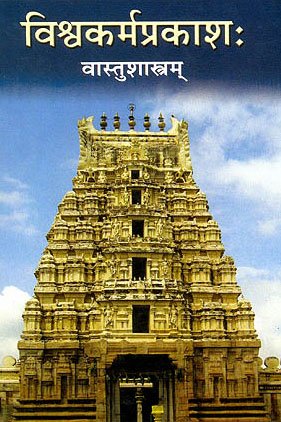
Vastushastra (वास्तुशास्त्र, vāstuśāstra) refers to the ancient Indian science (shastra) of architecture (vastu), dealing with topics such architecture, sculpture, town-building, fort building and various other constructions. Vastu also deals with the philosophy of the architectural relation with the cosmic universe.
Jyotisha (astronomy and astrology)
Source: Wisdom Library: Brihat Samhita by VarahamihiraDīkṣita (दीक्षित) refers to “those performing sacrificial rites”, according to the Bṛhatsaṃhitā (chapter 17), an encyclopedic Sanskrit work written by Varāhamihira mainly focusing on the science of ancient Indian astronomy astronomy (Jyotiṣa).—Accordingly, “If Mercury [i.e., Bhauma] should suffer defeat in his conjunction with Mars, trees, rivers, ascetics, the people of Aśmaka, the people of the north, sacrificial rites and the Dīkṣitas performing them (dīkṣita) will suffer much”.

Jyotisha (ज्योतिष, jyotiṣa or jyotish) refers to ‘astronomy’ or “Vedic astrology” and represents the fifth of the six Vedangas (additional sciences to be studied along with the Vedas). Jyotisha concerns itself with the study and prediction of the movements of celestial bodies, in order to calculate the auspicious time for rituals and ceremonies.
General definition (in Hinduism)
Source: academia.edu: The dīkṣita’s LanguageDīkṣita (दीक्षित) refers to the “consecrated man”, according to the Jaiminīya Brāhmaṇa, an ancient Vedic text associated with the Sama-veda predating the 6th century BCE.—The final portion of the Jaiminīya Brāhmaṇa 2.64 is devoted to the last rites before the ablution of the ‘consecrated man’ (dīkṣita), performed at the end of the solemn consecration introducing to the soma sacrifice.—The framework of this chapter is in fact a conversation between Keśin Dārbhya, the King of Pañcālas, and a deceased King named Yajñasena, in the form of a golden wild goose who instructs Keśin on consecration (dīkṣā). In general, the whole account (Jaiminīya Brāhmaṇa 2.53–68) is mentioned as kaiśinī dīkṣā, because it pertains to Keśin’s dīkṣā.
India history and geography
Source: Cologne Digital Sanskrit Dictionaries: Indian Epigraphical GlossaryDīkṣita.—(EI 22; CII 3, 4), same as Yajña-dīkṣita; epithet of Brāhmaṇas; later stereotyped as a Brahmanical family name. Note: dīkṣita is defined in the “Indian epigraphical glossary” as it can be found on ancient inscriptions commonly written in Sanskrit, Prakrit or Dravidian languages.

The history of India traces the identification of countries, villages, towns and other regions of India, as well as mythology, zoology, royal dynasties, rulers, tribes, local festivities and traditions and regional languages. Ancient India enjoyed religious freedom and encourages the path of Dharma, a concept common to Buddhism, Hinduism, and Jainism.
Languages of India and abroad
Marathi-English dictionary
Source: DDSA: The Molesworth Marathi and English Dictionarydīkṣita (दीक्षित).—m (S) One that has conducted a sacrifice: also any descendent of such person. 2 Engaged in a course of austerities or ceremonies; and fig. of arts, schemes, endeavors to accomplish an object gen. 3 fig. Expert, adroit, adept, eminently clever.
Source: DDSA: The Aryabhusan school dictionary, Marathi-Englishdīkṣita (दीक्षित).—m One that has conducted a sacri- fice: also any descendant of such person. Expert, adroit.
Marathi is an Indo-European language having over 70 million native speakers people in (predominantly) Maharashtra India. Marathi, like many other Indo-Aryan languages, evolved from early forms of Prakrit, which itself is a subset of Sanskrit, one of the most ancient languages of the world.
Sanskrit dictionary
Source: DDSA: The practical Sanskrit-English dictionaryDīkṣita (दीक्षित).—p. p. [dīkṣ kartari kta, dīkṣā jātā'sya tāra° itac vā]
1) Consecrated, initiated (as for a religious ceremony); एते विवाहदीक्षिता यूयम् (ete vivāhadīkṣitā yūyam) Uttararāmacarita 1; Pañcatantra (Bombay) 1.167; आपन्ना- भयसत्रेषु दीक्षिताः खलु पौरवाः (āpannā- bhayasatreṣu dīkṣitāḥ khalu pauravāḥ) Ś.2.17; R.8.75;11.24, Ve. 1.25.
2) Prepared for a sacrifice.
3) Prepared for, having taken a vow of; तं पितुर्वधभवेन मन्युना राजवंश- निधनाय दीक्षितम् (taṃ piturvadhabhavena manyunā rājavaṃśa- nidhanāya dīkṣitam) R.11.67.
4) Crowned; पद्मा पद्मातपत्रेण भेजे साम्राज्यदीक्षितम् (padmā padmātapatreṇa bheje sāmrājyadīkṣitam) R.4.5.
5) Performed (as the dīkṣā ceremony).
-taḥ 1 A priest engaged in a Dīkṣā; नालं ते विप्रियं कर्तुं दीक्षितस्येव साधवः (nālaṃ te vipriyaṃ kartuṃ dīkṣitasyeva sādhavaḥ) Rām.3.65.12.
2) A pupil.
3) A person who or whose ancestors may have performed a grand sacrificial ceremony, such as ज्योतिष्टोम (jyotiṣṭoma).
Source: Cologne Digital Sanskrit Dictionaries: Shabda-Sagara Sanskrit-English DictionaryDīkṣita (दीक्षित).—mfn.
(-taḥ-tā-taṃ) 1. Initiated. 2. Performed, (as the Diksha ceremony.) 3. One by whom the preparatory ceremonies have been observed. m.
(-taḥ) 1. An assemblage of priests for peculiar ceremonies, or for any sacrifice. 2. The pupil or an ascetick. E. dīkṣ to perform a sacrifice or to be initiated, affix karttari kta or dīkṣā jātā asya tāra0 itac vā .
Source: Cologne Digital Sanskrit Dictionaries: Cappeller Sanskrit-English DictionaryDīkṣita (दीक्षित).—[feminine] tī consecrated for ([dative], [locative], [instrumental], or —°), prepared, ready for ([dative], [instrumental], [locative], or —°); [abstract] tva† [neuter] — Often °— or —° in names, [especially] of Brahmans.
Source: Cologne Digital Sanskrit Dictionaries: Aufrecht Catalogus Catalogorum1) Dīkṣita (दीक्षित) as mentioned in Aufrecht’s Catalogus Catalogorum:—Sukhabodhanadīpikā.
Dīkṣita has the following synonyms: Puruṣottama miśra.
2) Dīkṣita (दीक्षित):—son of Mahādeva Vājapeyin, pupil of Viśveśvara. Middle of last century: Paśuprayoga Baudh. Paśubandhakārikā. Prayogaratna. Mahāgnicayanaprayoga. Mahāgnisarvasva Baudh. Mīmāṃsākutūhalavṛtti. Yājñikasarvasva. Sāvitrādikāṭhakacayana. Somakārikā. Vāsudevadīkṣitakārikā. Oppert. Ii, 5264. 5353. 7202. 7445.
Dīkṣita has the following synonyms: Vāsudeva adhvarin.
Source: Cologne Digital Sanskrit Dictionaries: Monier-Williams Sanskrit-English Dictionary1) Dīkṣita (दीक्षित):—[from dīkṣ] mf(ī, [Gopatha-brāhmaṇa i, 5, 24])n. consecrated, initiated into ([dative case] [locative case] [instrumental case], or [compound]), [Atharva-veda; Taittirīya-saṃhitā; Brāhmaṇa; ???; Manu-smṛti; Mahābhārata] etc.
2) [v.s. ...] prepared, ready for ([dative case] [instrumental case] or [compound]), [Mahābhārata; Rāmāyaṇa] (taṃ-√kṛ, to initiate, instruct, [Kathāsaritsāgara xx, 198])
3) [v.s. ...] performed (as the Dīkṣā ceremony), [Horace H. Wilson]
4) [v.s. ...] m. a priest engaged in a D° (-tva n., [Jaimini])
5) [v.s. ...] m. a pupil of (affixed, and rarely prefixed to the Name of a teacher, and given as a Name to a Brāhman to denote his being a pupil of that t° e.g. bhaṭṭoji-, śaṃ-kara-; sometimes the teacher’s Name is dropped and D° is used alone).
Source: Cologne Digital Sanskrit Dictionaries: Yates Sanskrit-English DictionaryDīkṣita (दीक्षित):—[(taḥ-tā-taṃ) p.] Initiated; done. 1. m. Assemblage of priests for any sacrifice; pupil of an ascetic.
Source: DDSA: Paia-sadda-mahannavo; a comprehensive Prakrit Hindi dictionary (S)Dīkṣita (दीक्षित) in the Sanskrit language is related to the Prakrit word: Dikkhia.
[Sanskrit to German]
Sanskrit, also spelled संस्कृतम् (saṃskṛtam), is an ancient language of India commonly seen as the grandmother of the Indo-European language family (even English!). Closely allied with Prakrit and Pali, Sanskrit is more exhaustive in both grammar and terms and has the most extensive collection of literature in the world, greatly surpassing its sister-languages Greek and Latin.
Hindi dictionary
Source: DDSA: A practical Hindi-English dictionaryDīkṣita (दीक्षित) [Also spelled dikshit]:—(a) initiated.
...
Kannada-English dictionary
Source: Alar: Kannada-English corpusDīkṣita (ದೀಕ್ಷಿತ):—
1) [noun] a man who has taken up an undertaking with determination, fervor and scrupulousness; a dedicated undertaker.
2) [noun] a man who is consecrated to take up a religious sacrifice.
3) [noun] a man who has performed the Sōma sacrifice.
4) [noun] a pupil of a religious preceptor.
Kannada is a Dravidian language (as opposed to the Indo-European language family) mainly spoken in the southwestern region of India.
See also (Relevant definitions)
Starts with (+4): Dikshita ananta, Dikshita balakrishna, Dikshita cakrapani, Dikshita damodara, Dikshita devadatta, Dikshita dhundhiraja, Dikshita samvatsara, Dikshita shri harsha, Dikshita shrikantha sharman, Dikshitabalakrishna, Dikshitabrahmana, Dikshitadhundhiraja, Dikshitar, Dikshitasamaraja, Dikshitatana, Dikshitatman, Dikshitatva, Dikshitavada, Dikshitavasana, Dikshitavedana.
Ends with (+151): Accadikshita, Acchadikshita, Adavashukla dikshita, Adikshita, Akshadikshita, Ananta dikshita, Annadikshita, Apayyadikshita, Appa dikshita, Appadikshita, Appaidikshita, Appayadikshita, Appayya dikshita, Appayyadikshita, Appidikshita, Apyadikshita, Apyaidikshita, Apyayadikshita, Apyo dikshita, Ayadikshita.
Full-text (+762): Diksh, Yajnanarayana, Praudhamanorama, Shaivakalpadruma, Bubasharman, Nilakanthavijayacampu, Kundamandapasiddhi, Virashaiva, Govindadikshita, Balamanorama, Sri Rangarajadhwari, Sudhanjana, Shabdabhedanirupana, Rangaraja, Lakshmidhara, Kuvalayananda, Gudhaphakkikaprakasha, Apyo dikshita, Nilakanthamakhin, Raghunandana.
Relevant text
Search found 56 books and stories containing Dikshita, Dīkṣita, Diksita; (plurals include: Dikshitas, Dīkṣitas, Diksitas). You can also click to the full overview containing English textual excerpts. Below are direct links for the most relevant articles:
Sanskrit sources of Kerala history (by Suma Parappattoli)
11. Prakriyasarvasva by Melpathur Narayana Bhattathiri < [Chapter 6 - Miscellaneous Sanskrit works bearing on Kerala history]
13. Ramavarma-Yasobhusana by Sadasiva-Diksita < [Chapter 6 - Miscellaneous Sanskrit works bearing on Kerala history]
10. Vasulaksmikalyana by Venkata Subrahmanya Dhavarin < [Chapter 5 - Sanskrit Dramas and Campus bearing on Kerala History]
Hindu Pluralism (by Elaine M. Fisher)
The Public Theologians of Early Modern South India < [Chapter 1 - Hindu Sectarianism: Difference in Unity]
The Making of a Hindu Sectarian Community < [Conclusion—A Prehistory of Hindu Pluralism]
Śrīvidyā and society in Nīlakaṇṭha Dīkṣita’s Saubhāgyacandrātapa < [Chapter 2 - The Making of the Smārta-Śaiva Community of South India]
Amarakoshodghatana of Kshirasvamin (study) (by A. Yamuna Devi)
Vedic Sacrifices < [Chapter 4 - Cultural Aspects]
Critical comments by Bhānuji Dīkṣita on certain derivations of Kṣīrasvāmin < [Chapter 6 - Grammatical Aspects]
Deviation from convention (Introduction) < [Chapter 6 - Grammatical Aspects]
Jivanandana of Anandaraya Makhin (Study) (by G. D. Jayalakshmi)
Family of Ānandarāya Makhin < [Chapter 2 - Author, His Life and Works]
Establishing the Authorship of Ānandarāya Makhin < [Chapter 2 - Author, His Life and Works]
Life of Ānandarāya Makhin < [Chapter 2 - Author, His Life and Works]
Manusmriti with the Commentary of Medhatithi (by Ganganatha Jha)
Verse 4.210 < [Section XIV - Other Duties]
Verse 2.128 < [Section XXIII - Rules regarding Salutation]
Preceptors of Advaita (by T. M. P. Mahadevan)
Related products
